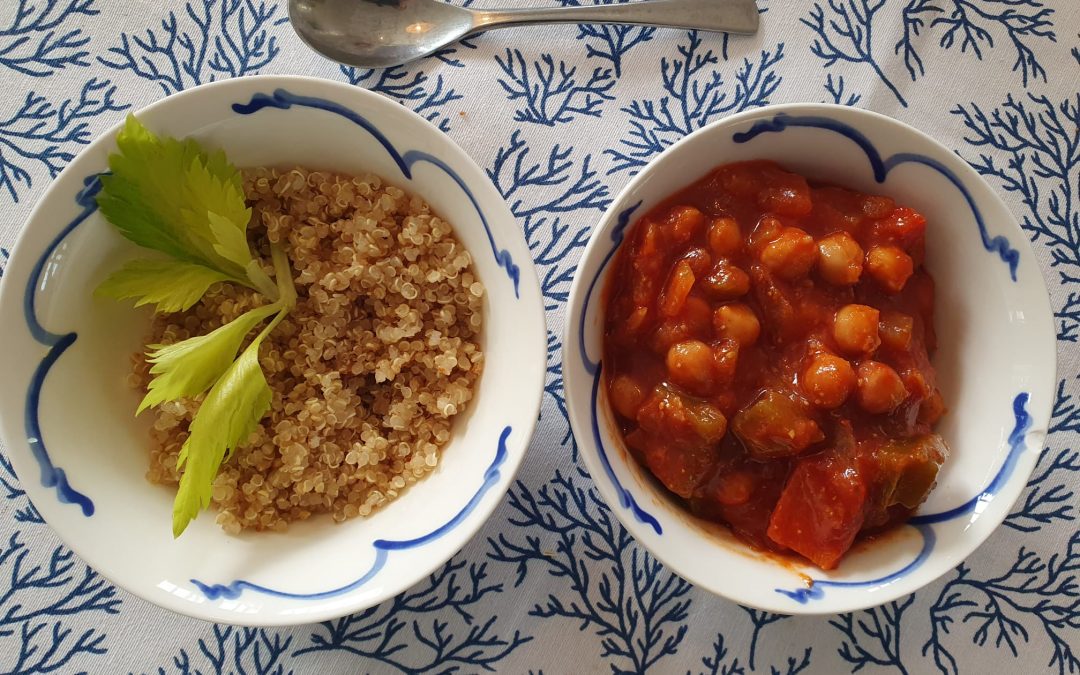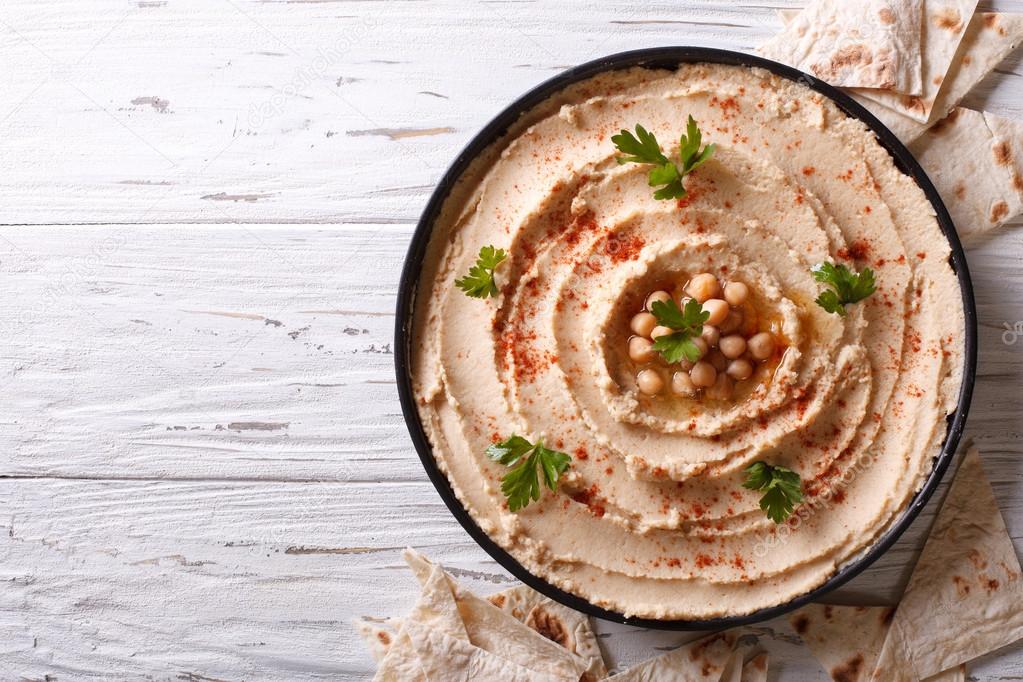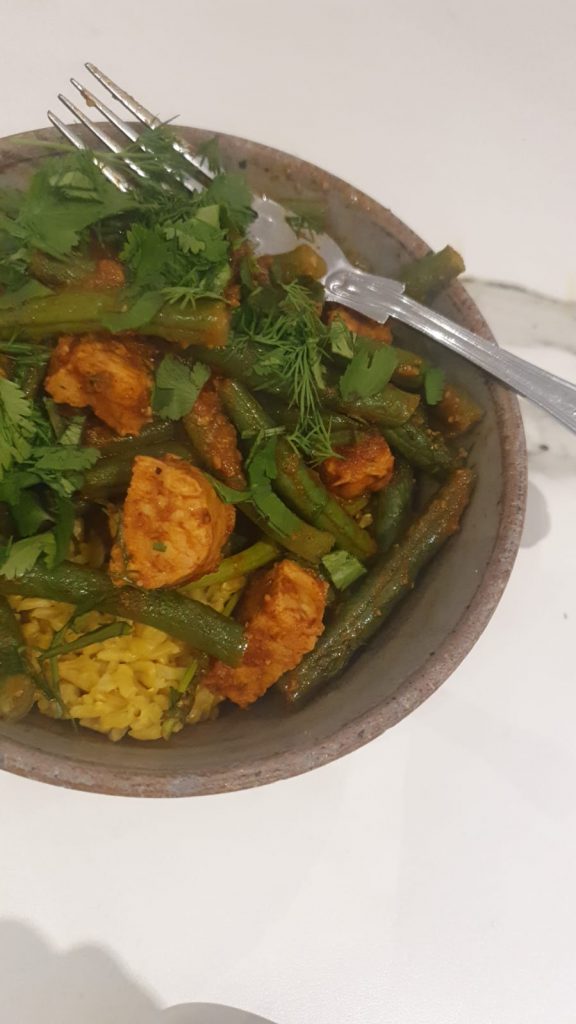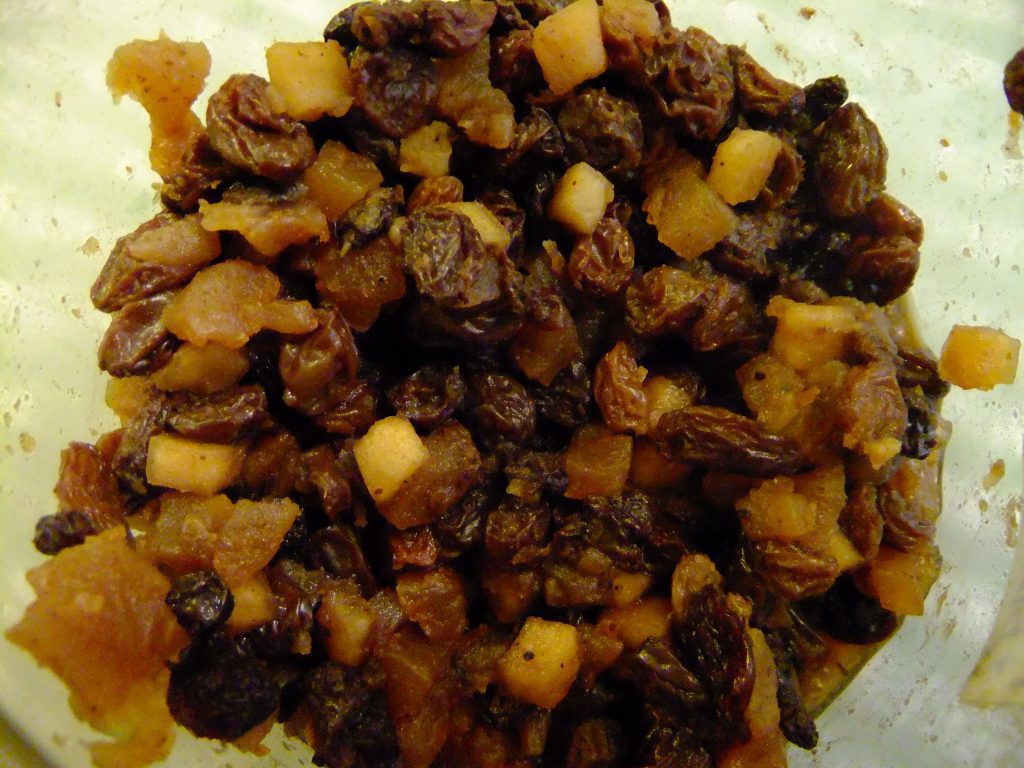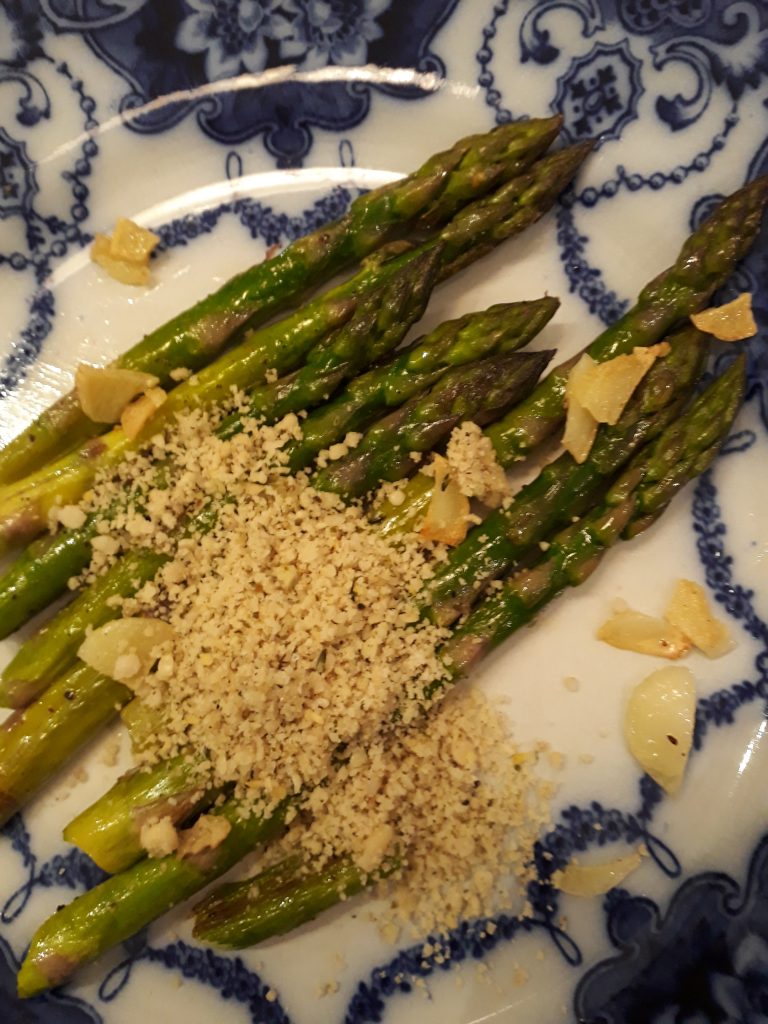
Nov 4, 2025 | Anna's Best Recipes
My mother used to cook this in the 1980s, long before vegan eating was a thing. I still love it and it’s so warming on a dark winters evening. It also works well with red kidney beans, white haricot beans or butter beans. I like to have this with quinoa for an extra protein kick but brown rice would also be OK.
For 4 (or 2 with freezer leftovers)
2 x 400g cans chickpeas (or 400g dried, soaked overnight then boiled hard till tender, reserving the cooking water)
2 medium onions, peeled and chopped fine
2 large green peppers (or 4 small), de-seeded and chopped fine
1 tbs extra virgin olive oil
1/2 tsp chili powder (optional)
Heaped teaspoon ground coriander
Heaped teaspoon ground cumin
Heaped teaspoon freshly grated ginger
4 tbs tomato puree
275ml boiling water or leftover veg-steaming water
lemon juice to taste
Sea salt/Himalayan salt and freshly ground black pepper
To serve:
Cooked quinoa (allow 1/4 cup of raw grains per person) or brown rice
Extra virgin olive oil
1. Heat a large heavy bottomed saucepan on a gentle heat, add oil, onions, green peppers, spices and 1 tbs of water. Cover with a lid and gently “steam-fry” until onions are translucent and softened but not brown. If everything begins to dry out, add another tbs of water.
2. While that’s happening, boil the kettle to cook your quinoa and put this on. If you’re not familiar with cooking quinoa, instructions are at https://annacollins.ie/how-to-cook-quinoa/
3. Dissolve the tomato puree in 275ml of reserved chickpea cooking water or boiling water. Add this, the chickpeas and some freshly ground black pepper to the vegetables and mix everything together.
4.Cook 10 minutes, add a little lemon juice, more black pepper and salt to taste.
5. Serve with the quinoa/brown rice and a drizzle of extra virgin olive oil
Why this is good for you:
There are a ton of reasons but I’ll just give you a few of them here.
Green vegetables are rich in magnesium, Nature’s tranquilizer and essential nutrient for detoxification, regular bowel, healthy blood sugar, and beautiful skin.
Chickpeas and onions are rich in prebiotic fibre to feed the healthy bacteria you need for every aspect of health – including healthy immunity, great gut health and a calm mind.
Herbs, spices and extra virgin olive oil are rich in polyphenols – plant antioxidants that are also super-intelligent “antibiotics”. Supporting friendly bacteria and lowering “bad” bugs that cause chronic ill-health.
Tomato puree is a powerful source of lycopene – this polyphenol (natural plant chemical) reduces inflammation, supports skin health, eyesight and keeps you youthful longer. Lycopene is more bio-available (usable by your body) when tomatoes are pureed/processed than when they are raw!
Protein rich – 1 cup cooked chickpeas gives you approximately 14.5-15g protein and 1 cup cooked quinoa 8g. That’s around 23g of protein. Most people, women especially, don’t eat enough protein. And that makes us more susceptable to stress, inflammation, infections and hormone imbalances (e.g. hypothyroid, PMS, problematic menopause…).
Raw extra virgin olive oil is a powerhouse of vitamin E which helps vitamin C to work for your immunity, your energy production and your infection control.

Sep 5, 2022 | Anna's Best Recipes, Sides, starters, soups & snacks
This is my all-time favourite potato salad. A far cry from the claggy, low-grade ones made with health-sabotaging refined oil. Amazingly, cold potatoes have very different health-giving properties from warm or hot. For the reason why, scroll to the bottom. Some people like to use waxy potatoes. Personally I prefer floury ones which partly break up. Serving size isn’t enormous as you’ll want to save space for masses of low carb veg and some quality protein to keep you fuller longer.
For 4
4 medium size potatoes (about 500g in all), scrubbed (no need to peel) and quartered
1/4 white/red onion, sliced thinly
Juice of 1/2 lemon
Large handful (3 tbs) chopped fresh parsley or dill
Freshly ground black pepper
Generous pinch salt
Liberal amounts of extra virgin olive oil
1. Boil the potatoes till cooked. Drain.
2. In a bowl combine hot potatoes, onion, 2 tbs extra virgin olive oil, salt, a few good grinds of black pepper.
3. If you like your onions not to have any “heat” add the lemon juice now.
4. Just before serving add the herbs and if you like, most extra virgin olive oil to taste.
Why this is good for you:
Cooked and cooled potatoes are a rich source of resistant starch. This magical starch feeds beneficial bacteria in your bowel that aid all aspects of your health. Resistant disappears if you reheat the potatoes and reappears when they are cold. Cooked, cooled rice is another good source of resistant starch. Herbs are a great source of antioxidants to calm inflammation and reduce the growth of unhelpful gut bacteria. Even a dessertspoon of cooked cooled rice or potatoes feeds friendly bacteria. Large amounts of high carb foods like grains, rice and potatoes are counter-productive as their high sugar levels promote overgrowths of unhelpful bugs. If you limit starchy carbs to no more than 1/4 your lunch and dinner plate you’ll be doing great!!

Jul 1, 2022 | Anna's Best Recipes, Dressings, rubs, spreads, sauces & more, Sides, starters, soups & snacks
There’s nothing like home-made hummus for flavour. It’s super-easy to do and if you like it, make a big batch and freeze some for the future.
1 mugful of cooked chickpeas (or haricot, cannellini, butter or broad beans) – keep some of the cooking water if you have cooked your own
OR
400g tin of no added sugar chickpeas, rinsed and drained
1½-3 tbsp olive oil (extra virgin)
2 large cloves garlic, crushed
Juice of ½ – 1 lemon
1 heaped dessertspoonful tahini (health stores/Asian shops. Raw tahini such as Carly’s brand is best)
Plenty of freshly ground black pepper
1 rounded tsp ground coriander
1 rounded tsp ground cumin
Generous pinch or two of Himalayan/Atlantic Sea Salt
Optional extras (see below)
- Blitz everything together in your food processor or mini food processor until mixed. You may need a bit more liquid (lemon juice or olive oil) to get everything mixing well.
- Add extra lemon juice/olive oil to taste. If the mix is too thick add a a bit of chickpea cooking water or plain water and blitz again.
Blitz in one or two of the following if you like:
- 2 tbsp chopped fresh coriander, parsley or chives,
- 3-4 tomatoes you have roasted or cooked under the grill till soft
- A teaspoon of spicy harissa paste (from ethnic shops) or ½ teasp chilli powder
- A teaspoon of sun dried tomato paste from the jar
- A teaspoon of black olive tapenade
- 2-3 roasted red peppers (available in jars from ethnic shops)
Tip:
Grinding your own cumin or coriander with a spice grinder gives a dramatically more flavoursome spice. This is because ground spices, when stored, lose some of their health-giving, aromatic oils. Always store your ground spices in an airtight container in a dark place.
Why this is good for you:
Most shop-bought hummus is made using cheap, refined (toxic) oils instead of the traditional extra virgin olive oil which is a superfood. It stands to reason that making your own is head and shoulders above anything else in quality and freshness.

Jan 30, 2022 | Anna's Best Recipes, Main courses
This is my current favourite way to use tofu or tempeh. I adapted it from Ottolenghi’s more complex recipe. My husband is a tofu-hater so when he disappears for a few days I always cook this. Keep in mind that unfermented soya products contain digestion-blocking proteins that damage your gut. So DO make sure to buy the fermented forms for this dish: tempeh or fermented tofu (it will say on the pack).
If you don’t have a small-bowl food processor, chop the chili finely, crush the garlic and use a pestle and mortar to bash the caraway seeds about as much as you can before mixing with the other spices and oil.
For 2
This is gorgeous served with cauliflower/broccoli “rice”, konjac noodles or brown basmati rice.
350g trimmed French (or use runner beans cut in 6cm bits)
Salt and black pepper
200g non-GMO tempeh or fermented tofu, cut into bite size cubes
A few sprigs of dill (small handful), destalked and roughly chopped
Small handful fresh coriander, destalked and roughly chopped
For the sauce:
4 garlic cloves, peeled and crushed
1 green or red chili, deseeded (optional)
2 slightly rounded tsp sweet paprika
1 tbs caraway seeds
1.5 tsp ground cumin
½ level tsp ground Ceylon cinnamon
2 tbs + a little extra avocado oil or extra virgin olive oil
3 tbs tomato puree
250ml water or leftover vegetable-steaming water (full of nutrients!)
Optional: 1 heaped tsp honey or non-toxic sweetener e.g. Dr Coy’s Stevia Erylite or xylitol (from good health stores)
2 limes
Black pepper
Himalayan or sea salt
- For the sauce put the garlic, spices, chili and 2 tbs oil in the small bowl of the food processer and blitz to a thick paste. You might need a touch more oil to bring it together.
- Heat a pan on a medium heat and add a teaspoon more of avocado/olive oil and stir fry the garlic-spice mix for 30 seconds.
- Then add the tomato puree, 250ml water and bring to the boil.
- Stir in the honey or non-toxic sweetener, lime juice, generous pinch (1/4 a level tsp) salt and a few good grinds of black pepper.
- Add the tempeh, turn down the heat, cover and simmer while you prep the green veg.
- Steam the French/runner beans for around 2-3 minutes until the colour changes very slightly and they are softened but still have a bit of crunch.
- Finally, just before serving, stir the herbs into the tofu and sauce, pile on top of your rice and enjoy.
Serve with:
Low carb: Cauliflower or broccoli rice https://www.annacollins.ie/cauliflower-rice/ or konjac noodles from Asian stores.
Medium carb: brown basmati rice cooked with a generous pinch of turmeric
Why this is good for you:
Spices are a powerhouse of antioxidants that help rebalance your gut bacteria in favour of the good guys. The good guys helps digest your food, repair and maintain your gut lining every minute of every day, and reduce inflammation in you. This has massive implications for your immune system, your gut health and even your mood. Yes, anxiety/depression states always involve brain inflammation. Type the name of just one spice into medline (the scientific journal resource) and you’ll find hundreds of peer-reviewed scientific studies.

Jan 14, 2022 | Anna's Best Recipes, Main courses
This is DELICIOUS, and simple and fast at 15 mins cook time. Had it for dinner last week and SO enjoyed its warming aromatic spices. I swapped out the refined cooking oil in the original recipe by Chetna Makan for healthier virgin coconut oil which doesn’t mess with your metabolism. If you don’t like coconut oil you could also use avocado oil or at a push light olive oil. The first 2 oils are healthier.
You’ll find tinned no-added-sugar black eyed beans in health stores and Asian shops.
Serves 4 (I like to make this quantity to have some yummy leftovers for the freezer)
2 tbs virgin coconut oil
2 large onions, peeled and finely chopped
2 big garlic cloves, peeled and grated or crushed
2½cm piece fresh root ginger, peeled and grated
400g tin chopped tomatoes
½ level tsp salt
¼-½ level tsp chilli powder or the milder cayenne (if you don’t like heat, leave out)
1 tsp garam masala
1 tsp ground turmeric
300g chestnut mushrooms, thinly sliced (white button mushrooms will do)
400ml tin full -fat coconut milk (organic brands, especially if you have any digestive issues at all)
2 x 400g tins black-eyed beans, drained and rinsed (or make your own – soak overnight 200g black eyed beans and boil hard until tender).
1.Heat the oil in a pan, add the onions, 2 tbs oil and a tablespoon of water. Cover with a plate or lid (or tinfoil) and cook on medium heat until softened, translucent and no longer crunchy.
2.Add the garlic and ginger, cook for a minute, then pour in the tomatoes and cook on a low to medium heat for five minutes.
3.Stir in the salt and ground spices, followed by all the remaining ingredients, stir well and bring to a boil.
4.Cover, then leave to cook on a medium heat for 15 minutes. (If you have more time, cook it over over a lower heat for 30-40 minutes.).
Serve warm with:
SC Diet: squash wedges sprinkled with curry powder and roasted in the oven + 2 cups steamed greens per person – nice ones are broccoli, runner/green beans or cabbage/spring greens.
Medium carb: ½ cup cooked brown basmati rice (avoid for SC diet) + 2 cups steamed greens per person – nice ones are broccoli, runner/green beans or cabbage/spring greens.
Low carb (SC diet-friendly): broccoli rice or cauliflower rice (available frozen in supermarkets). Super simple how to cook instructions at https://www.annacollins.ie/cauliflower-rice/
Why this is good for you:
Beans are a good source of protein while spices are powerful anti-inflammatories. Spices modify your gut bacteria in favour of the good, useful ones that control every (and I mean every) aspect of your health. Spices are more antioxidant gram for gram than any fruit or vegetable. Small quantities pack a powerful punch. Did you know that 1g turmeric twice a day is shown to reduce acid reflux (heartburn). Herbs and spices now have thousands (or maybe tens of thousands) of scientific studies confirming their actions on the human body. Whats not to like? A more interesting range of flavours in your meals AND massive benefits to your present and future health – digestive, mental, immune and so much more…

Nov 30, 2021 | Anna's Best Recipes, Cakes, biscuits & bars, Desserts & drinks
Don’t know about you but I’m really looking forward to Christmas and have started my baking already. This recipe is the nicest mincemeat and doesn’t boil over during baking. It’s adapted from Rose Cousin’s recipe but I’ve adapted specially for the SC diet. I’ve been making this for years because I love it. Somehow high sugar gloopy mincemeat stopped doing it for me. Store this mincemeat in a sterile glass jar. If you intend to store for more than a week or two, allow the mincemeat to cool a little before adding a tablespoon of brandy/whiskey. Mix well just before bottling. You can sterilise jars by boiling the lids in water and heating the jars themselves to around 80C in the oven for 15 minutes.
Organic where possible:
450g peeled cored eating (not cooking) apples – Cox’s are fantastic for flavour
225g unsulphured sultanas
225g unsulphured raisins
110g currants or chopped unsulphured apricots
Rind and juice of 1 orange (if avoiding citrus, use apple juice instead)
1/2 level teaspoon allspice
1/2 level tsp Ceylon cinnamon
¼ tsp ground or freshly grated nutmeg
1/4 tsp ground cloves
A little cloudy apple juice
1. Mix together all the ingredients in a large cooking pot with lid
2. Simmer very gently ½ hour
3. Taste and adjust the spice levels – I often like to add a bit more more cinnamon and allspice.
SCD pastry is hard to work so its best make 1 large pie base, pre-baked, then filled with your mincemeat and a lovely crumble topping before being baked again for a short time. You can also treat the mincemeat just like a crumble – that is, put it in a pie dish or deep ovenproof plate, liberally sprinkle over the topping, bake until golden and serve with shipped additive-free coconut cream (from health shops).
Crumble topping: https://www.annacollins.ie/scd-crumble-topping-for-mince-pies/
Pastry base https://www.alifeofhappenstance.com/easy-almond-flour-pie-crust/
If you don’t like coconut oil but are sensitive to dairy then you can use clarified butter for the pastry. Make this by very gently heating the butter, skim off the foam on the top and chill in a tall drinking glass or jug, then allow to solidify. You will use only the solid part to make your pastry. Discard the white liquid part underneath and rinse off any that’s clinging to the solid butter fat. This white liquid is where the problematic milk proteins and disaccharide sugars are found. Most people with IBD can tolerate SMALL amounts of normal butter but large amounts (found in pastry) can just be too much.
When baking your mince pies
Bake 20-25 mins at 185C fan/200C until golden
Put a baking try over the next rack in the oven so the pies cook evenly through.
Why this is (somewhat) better for you:
While I’d love to say this is a health-giving recipe I can’t really because its very high in natural sugars. Although it doesn’t contain refined sugar it IS very high in natural sugars from the dried fruit. BUT this mincemeat is free of low grade oils (like vegetable suet or sunflower oil) and refined sugar – both of which fire up inflammation in you. If you choose organic dried fruit you avoid sulphur dioxide (preservative) that wreaks havoc on so many peoples digestion around Christmas time. This preservative is converted by pathogenic bacteria in your bowel into irritating sulphites, which can cause gas, bloating and general unwellness in your gut. Non-organic grapes (raisins etc.) are also very heavily contaminated with herbicides that cause your gut to leak toxins and undigested food into your bloodstream.(increased intestinal permeability). This process predisposes to and perpetuates inflammatory conditions from autoimmunity to mood issues and many more besides. Pesticide residues in grapes damage the nerve supplying your gut and are linked to a range of neurological diseases (e.g. Parkinson’s, Motor Neurone). Choosing food free of undesirable contaminants is a great step towards better health. Here’s to a happy and a healthy Christmas. I will certainly be enjoying healthier mince pies – probably far too many.

Oct 3, 2021 | Anna's Best Recipes, Sides, starters, soups & snacks
I love this and I’ve made it so many times now I don’t need a recipe. Make it as cauliflower “steaks” or florets (a bit faster).
If you prefer an Indian vibe use a spice blend of 1 level tsp each of ground cumin, coriander and turmeric alongside the pepper and salt.
1 whole cauliflower, green leaves removed
1 heaped tsp ground sumac or sweet paprika
Freshly ground black pepper
Pink (Himalayan) salt
Extra virgin olive oil (about 2-3 tbs)
Roast cauliflower “steaks”
Preheat oven to 215c/200C fan
With the cauliflower standing on its stalk, slice it downwards into 1.5-2cm slices. You’ll get 4-5 good “steaks” and some shards.
Brush the roasting tin with extra virgin olive oil lay the cauliflower slices on top rubbing them around a bit to coat with the oil without breaking them up.
Brush the tops with olive oil, sprinkle with the sumac/paprika, lots of freshly ground black pepper and a generous pinch of salt.
Roast 15-20 mins at 200C. It’s done when the edges are starting to char.
Roast cauliflower florets
Take out central thick stalk from the cauliflower and break into small florets.
Put in the roasting dish, drizzle on extra virgin olive oil, sprinkle on your spices, pepper and salt and toss to coat.
Roast 10-15 mins at 220c/fan 200c.
Its done when the edges are starting to char.
If you feel like a fancier recipe with a delicious middle eastern dressing go to my blog post https://www.annacollins.ie/oven-roasted-cauliflower-green-bean-salad/

May 26, 2021 | Anna's Best Recipes, Cakes, biscuits & bars
I can’t remember the cookbook these come from but my thanks to the amazing Emily and Patrick at Madawaska who produced these gorgeous bites using gluten-free oats. They didn’t last long. If you have the time and like a nuttier flavour, you can toast the oatflakes first like they did. I don’t bother. People really love these and they are super-easy. I did replace the bad-for-your-health margarine in the original recipe for a far healthier virgin coconut oil though.
Using non-dairy milks in these gives a much longer shelf-life in the fridge. The best plant milks have no toxic emulsifiers (carageenen, polysorbate-80, sodium carboxymethylcellulose) and no added sugar.
Makes 36 (enough to feed a small army!)
2½ rounded tbs cocoa powder
¾ cup maple syrup
¼ cup unsweetened non dairy milk (e.g. almond, coconut, hemp)
1/3 tsp vanilla extract (avoid vanilla “essence” unless you are OK eating gluten)
¼ cup virgin coconut oil
1½ cups fine gluten-free oatflakes (you can use normal porridge oatflakes if you eat gluten)
¼ cup no-added-sugar almond or hazelnut butter (if you are in peak health with no autoimmune conditions then no-added-sugar smooth peanut butter is OK to use)
1¾ cups dessicated coconut (divided into 1 cup and ¾ cup)
1. Mix the cocoa and syrup together in a saucepan, add the milk vanilla and coconut oil. Heat gently until liquified and stir to mix well, scraping the sides, being sure not to let it boil or burn. Cool mixture.
2.In a separate bowl combine oats, peanut butter together using your hands. Pour in tht cocoa mixture and add 1 cup coconut. Mix well with your hands.
3.Roll dough into 2.5cm balls. If the mix is too wet you can add more oatmeal or roll the balls into the remaining coconut. They will be somewhat sticky but will harden as they cool. Put on a try and store in the fridge.
Tip:
I wanted to make them stick really well together so added some more oatflakes I had whizzed to a flour in my mini food processor. Oat flour is stickier than oatflakes. I probably didn’t need to do this but liked the result.
Why these are better for you:
Although these contain carbohydrate (sugars) from oats and maple syrup they are healthy when you eat them in moderation. Raw cocoa is full of antioxidants. Virgin coconut oil is a great source of easy to digest medium chain triglycerides that can be burned by your body directly for energy instead of being stored as fat.
Oats contain soluble fibre that feeds beneficial bacteria. Maple syrup is essentially sugar, but it does contain some minerals – unlike refined sugar, which is just empty calories. The protein from peanut butter and the fat from coconut keeps you fuller for longer, reducing the tendency to binge you can get from eating low fat low protein high sugar products.
Cocoa is a spice with antioxidant and anti-inflammatory powers – hurray!!
Like gluten grains, peanuts are high in “lectins” – proteins that are hard to digest and can overstimulate your immune system if you have an autoimmune condition (e.g. hypothyroidism, Crohn’s, ulcerative colitis, arthritis),

Feb 25, 2021 | Anna's Best Recipes, Dressings, rubs, spreads, sauces & more, Sides, starters, soups & snacks
If you’re dairy sensitive, one of the things you might miss is a sprinkle of Parmesan here and there. I LOVE this recipe for vegan Parmesan from Angela Elliot’s raw vegan cookbook “Alive in 5”. One of my favourite uses is on top of garlic braised asparagus. I soften 2-3 sliced cloves of garlic on a pan with a tbs extra virgin olive oil and same amount of water until softened. Then I add a bunch of asparagus, cover with a lid/plate, and gently cook for a few minutes until the asparagus has gone bright green. This means it’s done. Dish up and sprinkle with the “Parmesan”. Yum!!!
1 cup raw pine nuts (or half and half pine nuts and hemp hearts, which are more economical than pine nuts and give a creamy texture)
1/4 cup nutritional yeast powder/flakes
1/2 a level teaspoon of Himalayan salt
1 level tsp dried oregano.
Combine the nuts/hemp hearts, yeast, salt and oregano in a mini food processor or electric coffee grinder and pulse until it looks like breadcrumbs.
Keep this in an airtight glass jar in the fridge until you need it.

Jan 24, 2021 | Anna's Best Recipes, Main courses, Sides, starters, soups & snacks
This was a lovely curry my mother used to make from time to time. If you are making this a vegan dinner, its a great idea to bump up protein by serving with cooked quinoa and maybe adding some tinned chickpeas along with the courgettes. Otherwise you are very low on protein. I might also sometimes have this as a side with something fish/meat based and some cauliflower rice.
For 2:
1 medium onion, chopped
300g frozen or fresh shelled peas
1 large (around 350-400g) courgette, sliced
1 medium carrot, sliced thinly
1 dsp extra virgin coconut oil
1 dsp grated or finely chopped fresh ginger
1 tsp ground turmeric
½ level tsp chilli powder or cayenne (omit if you don’t like heat!)
1 dsp garam masala
Himalayan salt to taste
1 dsp lemon juice
1.Heat oil in saucepan on a medium heat, add a splash of water (about a tablespoon).
2.Add carrots, onion, ginger, turmeric, chilli powder if using and cover with a lid or a plate. Steam fry like this until carrots are softened and onions translucent. If everything starts to dry out and stick, add a splash more water.
3.Add peas and courgettes, cover and cook till soft, around 5 minutes usually. Tip: If you using frozen peas, rinsing them in hot water to thaw before adding to the pot will speed up the cooking.
Serve with one of these:
Grilled fish or chicken
A meat or fish curry
Cooked quinoa (not suitable for SC Diet): 1 cup quinoa, 2 cups boiling water, simmer covered till done – serves 2
Why this is good for you:
If you’ve been following me you’ll know by now that regularly eating a wide range of herbs, spices and different vegetables is important for your immune system, your mental health and for warding off tendencies to any sort of inflammatory condition. Turmeric and ginger in particular have thousands of peer reviewed research papers devoted to their various therapeutic actions. Part of their therapeutic action comes from their effects on your gut micro-organisms. They selectively discourage pathogenic bugs and encourage the good guys!!! Herbs and spices also stimulate your body to upregulate its OWN antioxidant defences. The antioxidant activity of these precious flavour bombs also helps reduce brain inflammation. If you are anxious, low or have any mental health issue your brain is inflamed. That’s why eating a (home made, with good quality oil like coconut) curry a couple of times a week and incorporating herbs and spices into every single day could really change your life. Happy eating….
